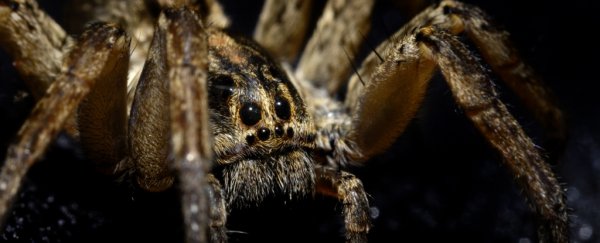Grey wolves are among the top predators on the Arctic tundra, but there's a little fellow underfoot who has their lupine compadres beat.
A calculation for a new paper estimates that, in terms of raw biomass, the wolf spider outweighs the grey wolf by just over 80 to 1.
That, friends, is a lot of spiders skittering over the vegetation in the remote North, hunting for their prey.
And, thanks to climate change, they're only going to grow bigger and more abundant as temperatures continue to climb.
OK, keep your cool, put away your flamethrowers. For a start, that's silly, they're a vital part of the ecosystem.
Secondly, as this new research has found, the effect of climate change on wolf spiders may turn them into a sort of climate change countermeasure (although it's going to take more than a few tons of spiders, so don't ease off on your activism either).
That little positive is all down to what the spiders like to eat. When temperatures warm, wolf spiders' food preferences change, creating a sort of cascading effect that results in a slower release of carbon dioxide into the atmosphere.
Conducted by biologist Amanda Koltz of Washington University in St Louis and colleagues, the research involved setting up isolated miniature ecosystems at different temperatures to see the effect, not just on the spiders, but on predator-prey interactions, and the entire system as a whole.
"We often think about how warmer temperatures might strengthen or weaken interactions between predators and their prey," Koltz said.
"But in this case we show that when warming alters those interactions, it can also lead to changes in ecosystem-level processes like decomposition rates."
The spiders' regular food of choice is a fellow arthropod called Collembola, or springtails.
This busy little bug is what is known as a detritivore. They perform an important ecological role by feeding on decaying plant matter and fungus below ground, and keeping the decomposition rates in check.
This is because fungus in the tundra expedites the decomposition - a process that results in the release of carbon dioxide and methane into the atmosphere.
So more spiders means fewer springtails, which means faster decomposition, which means a faster CO2 and methane release.
But when temperatures get warmer, and spider numbers are higher, the team noticed something curious happening. The springtail populations in these mini ecosystems did not fall as much as expected, and decomposition rates under the ground were therefore slower.
In those conditions, it seemed that the spiders became less interested in springtails, preferring to munch on other food sources - although what those food sources might be wasn't exactly clear.
The research team thought it might be the smaller wolf spiders, but further research will need to be conducted to find out for sure.
"The way that organisms interact with one another can influence important ecosystem functions like how much carbon stays fixed by plants, how quickly decomposition happens, and how nutrients are cycled within that ecosystem," Koltz said.
"Controls on nutrient cycling in the Arctic are very important for us to understand, because this region plays a disproportionately large role in the global carbon cycle."
The current research, however, is still very interesting, showing that perhaps nature does take measures to self-correct when conditions make a drastic change. And it also shows that sometimes it's the little guys who are having a bigger impact.
"Spiders are not going to save us from climate change, but we found that decomposition is slower under warming when there are more wolf spiders present," Koltz said.
"They could be alleviating some of the effects of warming on carbon losses from the tundra. It's a good thing."
The research has been published in the journal PNAS.
